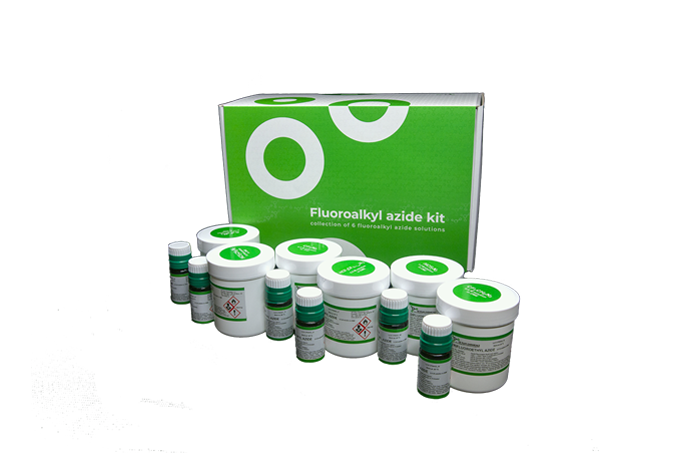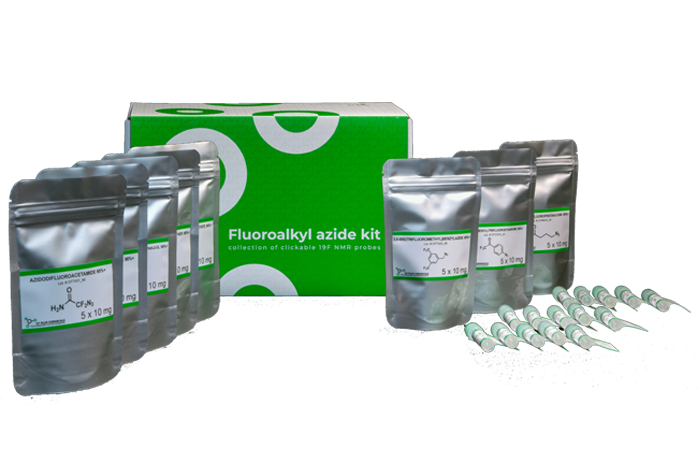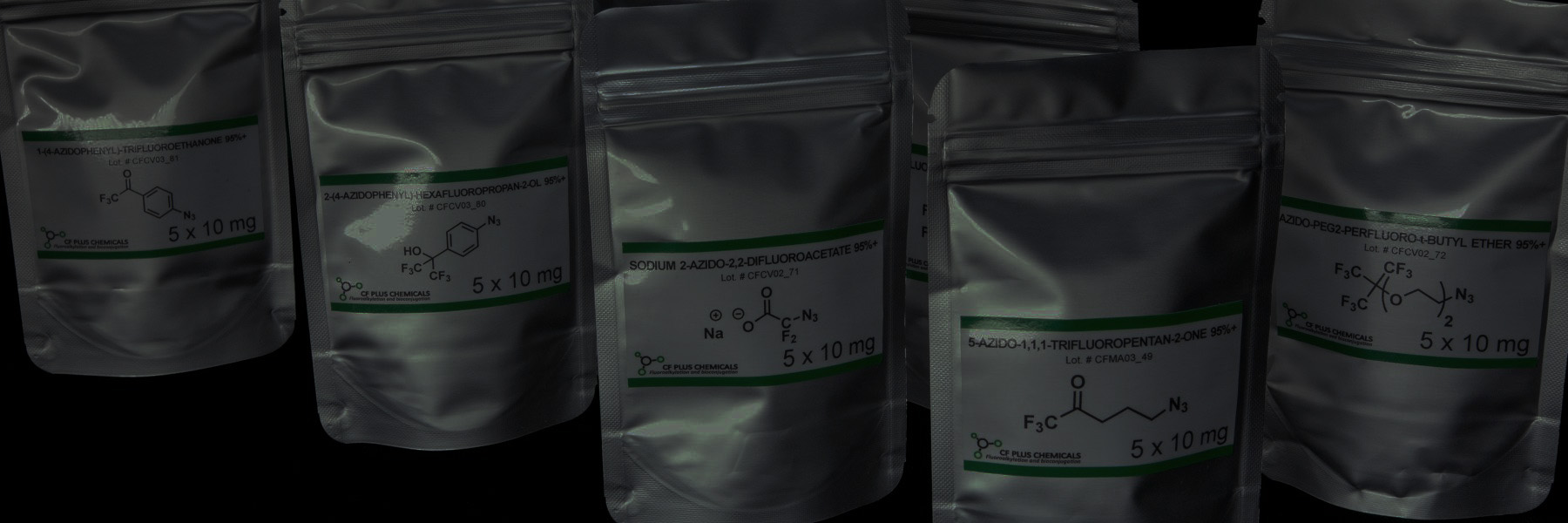
Fluorinated azides
Explore new chemical space in drug discovery and uncover biomolecular interactions with fluorinated azide kits
Fluorinated azides are a rare, but multi-purposed chemical speciality. A diverse array of fluorinated azides opens access to a new chemical space - creating a wealth of previously inaccessible fluoroalkylated heterocycles that are particularly attractive for development of new drugs and more effective pesticides.
The robustness and aqueous compatibility of click chemistry makes this group of reagents fit for emerging high-throughput discovery technologies based on combinatorial chemistry, such as DNA-encoded libraries.
In addition to that, the ease and predictability of click chemistry coupled with structural variety of our fluorinated azides also open up new possibilities in chemical biology and structural biology. With an alkynylated biomolecule in hand, various fluorinated groups can be easily and site-selectively attached and function as a sensitive 19F NMR reporter group for structural NMR studies. Alternatively, the fluorinated groups can bring with itself additional functionalities, such as improved binding to a target protein or coordination of metals.
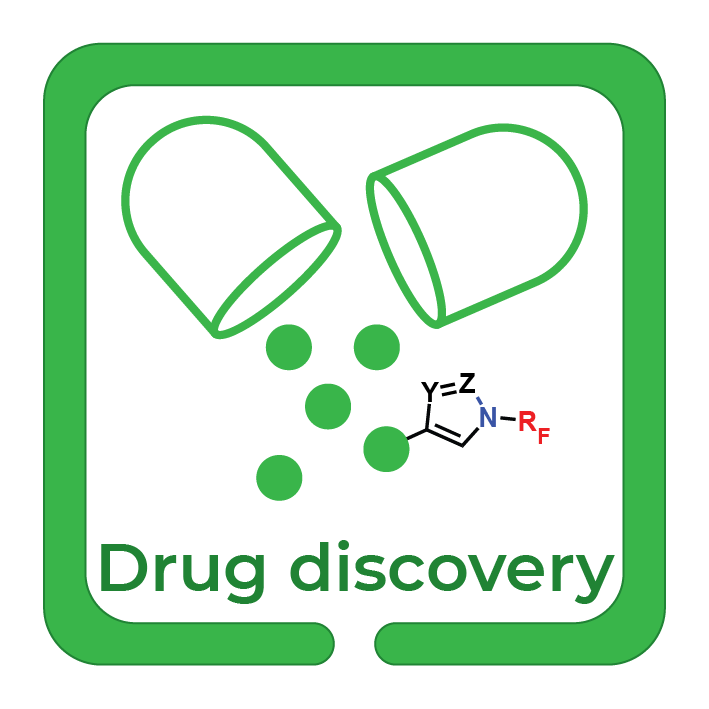
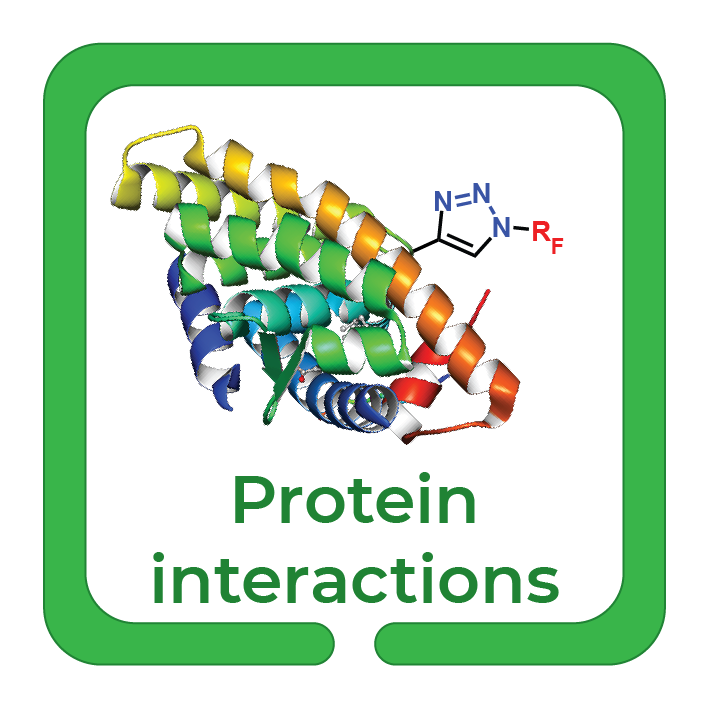
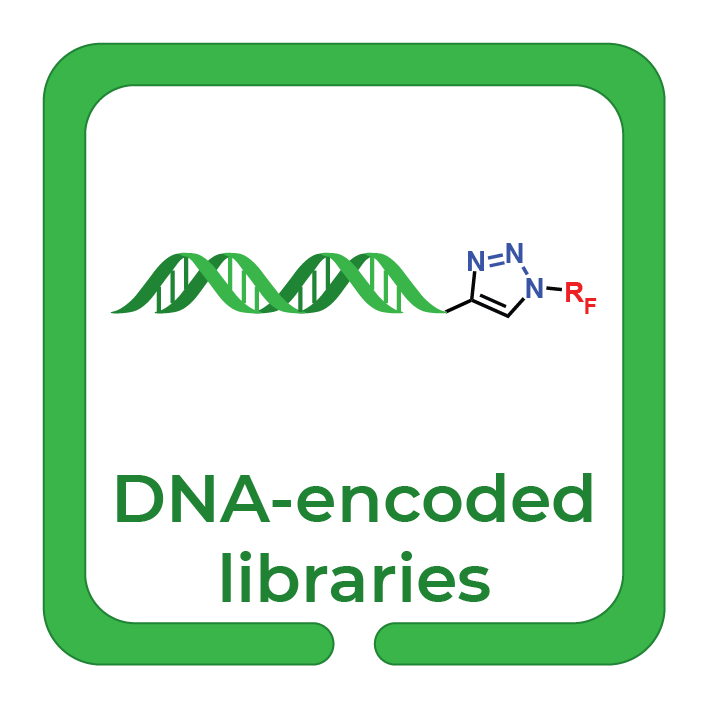
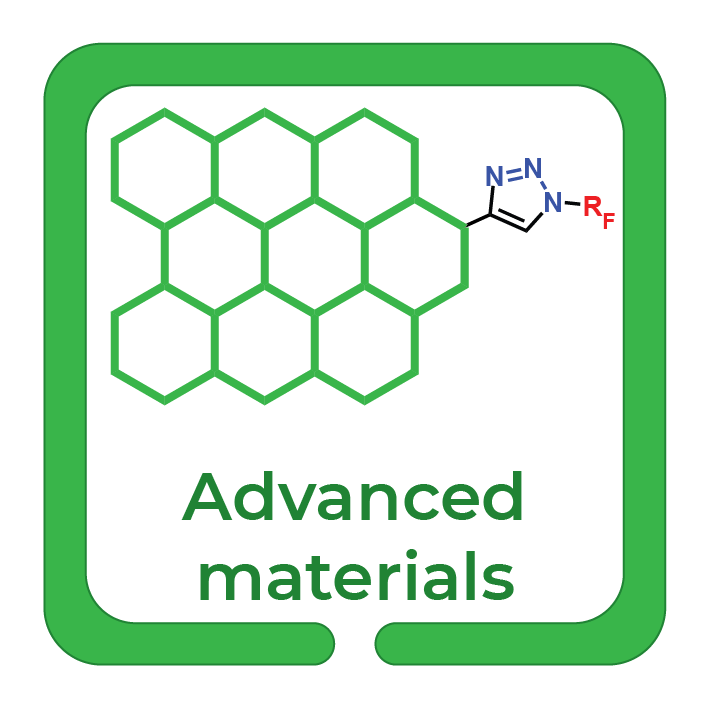
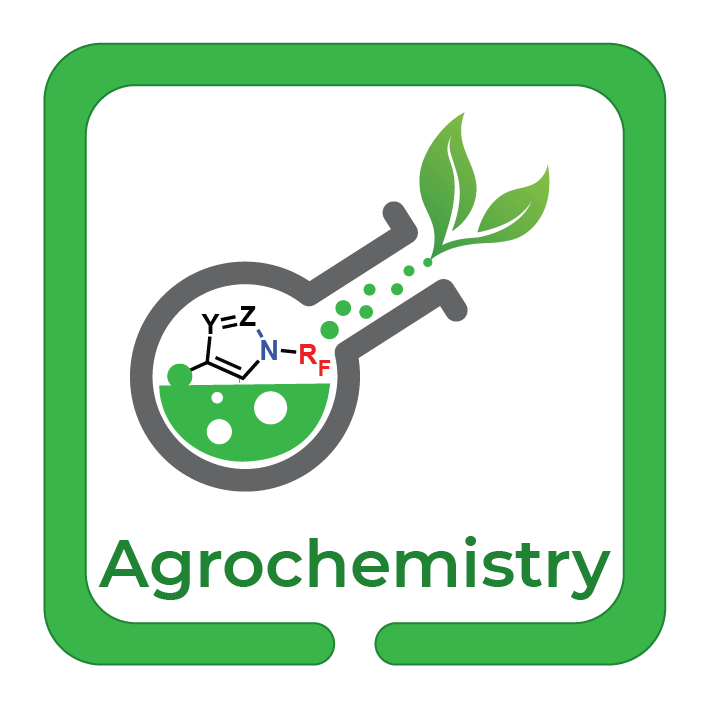
A collection of 6 fluoroalkyl azide solutions: access to a new chemical space by click chemistry.
A collection of 9 structurally diverse fluoroalkyl azides which can be used both as clickable 19F NMR probes for structural biology or advanced materials as well as a source of fluorinated functionalities for medicinal chemistry, agrochemistry or advanced materials.
We continuously strive to improve our products, therefore we would like to ask you for a 5-min feedback and give you a free bonus as a reward. Give a feedback
Fluorinated azides for drug discovery
Fluorinated motifs are becoming more common among drugs and modern pesticides as a tool to improve their efficacy by modulating their chemical and biological properties.
Want to create trifluoromethyl-, difluoromethyl-, difluoroethyl-, trifluoroethyl- or tetrafluoropropyl- containing heterocycles and amines and diversify your compound libraries?
Now there is one more way to do it.
Cu-catalyzed azide-alkyne click reaction
All fluoroalkyl azides undergo copper catalyzed alkyne-azide cycloaddition, forming 1,4-regioisomers in high selectivity.
Perfluoroalkyl azides
Perfluoroalkyl azides are exotic and highly useful reagents that allow access to N-perfluoroalkyl triazoles by copper-catalyzed click chemistry and by azide-ketone cycloaddition.
N-perfluoroalkyl triazoles themselves serve as precursors that undergo Rh-catalyzed transformations with various partners, affording N-perfluoroalkyl imidazoles, pyrroles, pyrrolones and imidazolones, which are interesting, but otherwise hard-to-synthesize fluorinated drug-like motifs.
Other fluorinated azides
Most of the products in this subclass help to incorporate RCF2H moieties into a molecule. The highly polarized C–H bond of CF2H makes this group a competent hydrogen bond donor, a unique characteristic amongst polyfluorinated motifs.
Trifluoroethylation is a popular strategy in drug design to lower the pKa values of attached nitrogen heterocycles and amines, as well as improving metabolic stability of drug candidates.
Transformations of N-(per)fluoroalkyl triazoles
N-Fluoroalkyl-1,2,3-triazoles undergo various denitrogenative transformations when heated in a microwave in the presence of a Rh(II)-catalyst. The reaction proceeds through via Rh-carbenoid reactive intermediates. N-Trifluoromethyl nitrogen heterocycles, such as pyrazoles or benzimidazoles are stable towards hydrolysis unlike N-trifluoromethyl secondary or tertiary amines. These azoles display favorable medicinal chemistry properties, such as increased lipophilicity and Caco2 permeability, no reactivity with glutathione and decreased pKa, which makes them interesting building blocks in drug design. Although N-trifluoromethyl azoles are rare compounds, this moiety is starting to appear in potential drug candidates. For example, replacing the methyl substituent on nitrogen in the checkpoint kinase 1 (CHK1) inhibitor for the trifluoromethyl group resulted in suppressed N-dealkylation while keeping comparable inhibitory activity.
Clicking of the fluorinated probes
In structural chemical biology, fluorinated azides can be clicked to alkynylated biomolecules (proteins, nucleic acids, glycans, etc.) and serve as sensitive 19F NMR probes. This approach eliminates the need for cumbersome de novo synthesis of complex fluorinated precursors and allows rapid screening of the best performing fluorinated probe out of a diverse library.
Additionally, many of the clickable 19F NMR probes can be equally employed as interesting fluorinated groups to improve the properties of drug and pesticide candidates as well as for late-stage decoration of alkynylated advanced materials.
Nonafluoro-t-butyl ethers
Nonafluoro-t-butyl ethers are typical representatives of the relatively hydrophobic high-intensity 19F NMR probes. Depending on whether the reporting group needs to reflect changes in the chemical environment close to the attachment point or farther from it, short or medium length fluoroalkyl azide can be selected.
Derivatives of azidodifluoroacetic acid
Despite being low in 19F integration intensity, derivatives of azidodifluoroacetic acid are probably one of the least sterically demanding fluoroalkyl azides that also display excellent aqueous solubility without any cosolvents.
While sodium azidodifluoroacetate introduces a charged residue, the corresponding primary amide is mildly acidic and the hydroxamic acid is expected to act as a potential metal binder and metalloenzyme inhibitor. All these three azides are expected to have significantly lower pKa values than their non-fluorinated counterparts.
In the context of medicinal chemistry, α,α-difluorinated carboxamides and hydroxamates are potentially attractive due to their significantly altered acidobasic behaviour.
Trifluoromethyl ketones
Due to the powerful electron-withdrawing effect of the CF3-group, trifluoromethyl ketones are excellent carbonyl electrophiles which reversibly form adducts with various nucleophiles, such as water, oxygen- and nitrogen-centered nucleophiles derived from amino acid side chains.
Therefore they can be used to sense the local degree of hydration, proximity of certain amino acids, such as serine, act as a reversible "molecular glue" or represent the warhead part of a reactive inhibitor. It has been shown that trifluoromethyl ketones inhibit serine proteases through hemiacetal-forming interference with the oxyanion hole.
Other fluorinated aromatic azides
In the context of structural 19F NMR studies, bis(trifluoromethyl)-azidomethylbenzene and 4-azidophenylbis(trifluoromethyl)carbinol represent medium intensity probes. While the sensing performance of the highly lipophilic bis(trifluoromethyl) azidomethylbenzene is based on π-π interactions, the mildly acidic fluorinated tertiary alcohol might additionally act as a hydrogen bond donor.
In medicinal chemistry, bis-trifluoromethylated aromatic scaffolds represent a privileged motif.

